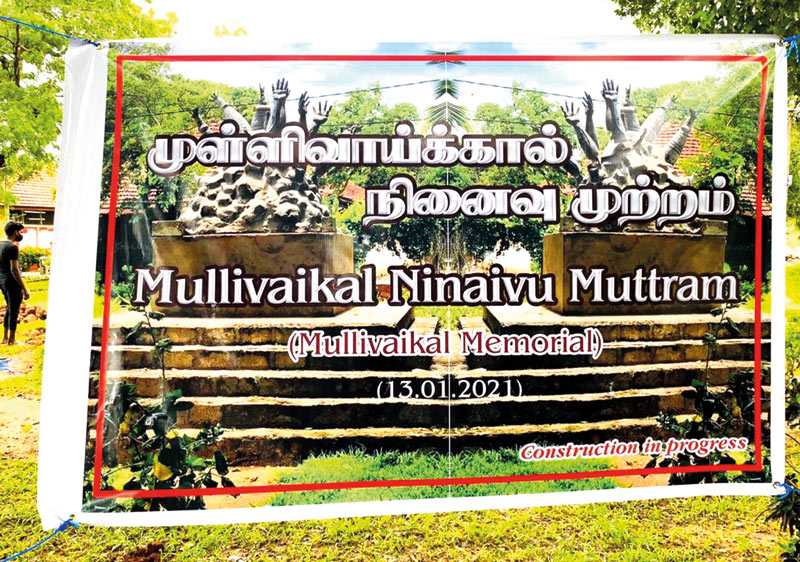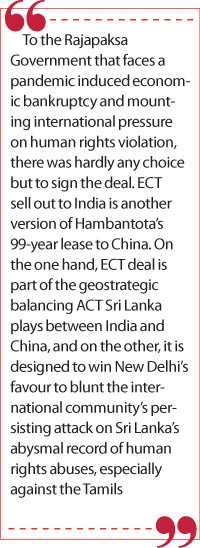Sunday Apr 20, 2025
Sunday Apr 20, 2025
Thursday, 21 January 2021 00:00 - - {{hitsCtrl.values.hits}}

When the stealthy demolition of the Mullivaikkal memorial monument inside the Jaffna University campus threatened to spill over into Tamil Nadu, India acted quickly and quietly to repair the damage. The hands that demolished the monument were forced to lay the foundation for its reconstruction. Does it do enough to quell the doubts in Tamil minds?
 With 49% of the East Container Terminal (ECT) handed over to the Indian Adani Group, in spite of strong opposition from Sri Lankan trade unions and anti-Indian nationalists, India has gained a strategic foothold in Sri Lanka.
With 49% of the East Container Terminal (ECT) handed over to the Indian Adani Group, in spite of strong opposition from Sri Lankan trade unions and anti-Indian nationalists, India has gained a strategic foothold in Sri Lanka.
To the Rajapaksa Government, it was a deal, according to the Prime Minister, to save 66% of trans-shipment business in the terminal, which is linked to India. To New Delhi on the other hand, the Adani presence, in addition to the economic benefit it brings to her GNP, is also of great strategic value in the context of Indian Ocean geopolitics and the future development of its own port facilities such as the Mumbai Port Terminal. To Adani Group itself, it is, above all, a lucrative business deal.
And finally, to the Tamil community of Sri Lanka, it raises an all-important question of how dependable would India be in future in helping the community to achieve justice in its struggle for power sharing with the Sinhalese majority.
The Adani business group is one of if not the most dominant and influential representatives of global capital in India. As always and everywhere the primary interest of capital is to make profit, and it will nestle with any political party or group or interest anywhere that vows to protect and promote its business interests. It is therefore neither patriotism nor Hinduism that threw Adani’s support behind Modi’s BJP, but BJP’s commitment to enhance the interests of capital. The ECT deal is testimony to the success of Modi-Adani economic and political alignment.
To the Rajapaksa Government that faces a pandemic induced economic bankruptcy and mounting international pressure on human rights violation, there was hardly any choice but to sign the deal. ECT sell out to India is another version of Hambantota’s 99-year lease to China. 
On the one hand, ECT deal is part of the geostrategic balancing ACT Sri Lanka plays between India and China, and on the other, it is designed to win New Delhi’s favour to blunt the international community’s persisting attack on Sri Lanka’s abysmal record of human rights abuses, especially against the Tamils.
For a long time, the Tamil community in Sri Lanka expected the support of New Delhi via Tamil Nadu in its struggle for some form of power sharing with the Sinhalese majority. Therefore, it came as terrific disappointment when India, after raising false hopes, let down the LTTE high and dry and at the mercy of a merciless Sinhalese military directed by the current President GR, during the final phase of the civil war.
Tamil losses were immense, wounds were deep and the scars are still not healed. However, the Indian initiated 13th Amendment gave a glimmer of hope to afflicted Tamils; and when Prime Minister Modi secured a promise from GR to implement the provisions of that amendment in full, Tamil leaders’ expectations obviously ran high.
When GR backtracked on his promise after returning from New Delhi, Modi did not show any bitterness outwardly, but continued to advocate his Neighbourhood First policy with Sri Lanka. India, as promised, loaned $ 400 million to Sri Lanka’s infrastructure projects, and the Indian Reserve Bank signed currency swap arrangements with SLBC for $ 400 million with the possibility of another deal for one billion dollars. Diplomatically viewing, all this were baits to capture the shark and that shark is the Adani deal. How could GR and his MR Government refuse now?
Once again, these economic transactions and commercial deals between the two countries raise doubt within the Tamil community about New Delhi’s commitment to arbitrate justly on the Tamil issue.
Just a week ago, the stealthy demolition of the Mullivaikkal memorial monument inside the Jaffna University campus, which provoked spontaneous student protests and hunger strike in the north and east, raised sympathetic voices from the Muslim community, which has its issues with the GR-MR regime, and threatened to spill over into Tamil Nadu, India acted quickly and quietly to repair the damage. The hands that demolished the monument were forced to lay the foundation for its reconstruction. Does it do enough to quell the doubts in Tamil minds?
For the local Tamil community, realpolitik dictates that shouting through Tamil Nadu is politically inaudible in New Delhi, because Modi’s BJP did not need Tamil Nadu (TN) support to come to power, and as things are, with Hindu nationalism reigning supreme in the central and northern states, Modi may not need TN support if he decides to run again to capture the capital.
Also, at least on the communal issue, there is perfect amity between Modi’s anti-Muslim Hindu nationalist vote bank and GR-MR’s anti-Tamil cum anti-Muslim Buddhist nationalist counterpart. Now, with mutual economic interests tied closely between the two regimes thanks to the Adani deal, New Delhi’s interest on the Tamil issue is destined to wane.
It may at best work with GR-MR for a virtually powerless Provincial Council system to satisfy Tamil aspirations. Tamils have no choice therefore, but to join hands with the other disgruntled community, Muslims, and get their grievances heard internationally.
In the meantime, how much of economic benefit would Sri Lanka receive from the operation of Adani deal is yet to be seen. Trade unions are worried that ECT would be swamped by Indian labour, just as Chinese are working in tens of thousands in China-initiated joint projects.
At the same time, the anti-Indian Buddhist nationalists fear that Indian meddling in Sri Lankan affairs would be permanent. This is the price the country is paying for seven decades of self-destructive communal politics. It will be interesting to watch, however, China’s next move.
(The writer is attached to the School of Business & Governance, Murdoch University, Western Australia.)